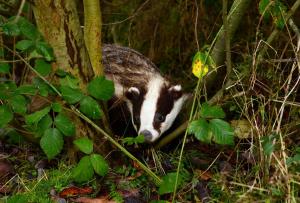Unexpected variation in badger behaviour found by scientists may cause a rethink on impacts of bovine TB interventions
Date published:
European badgers are a widely distributed and extremely adaptable species, but within Ireland and the UK they particularly like agricultural land, where, unfortunately, they can act as a wildlife reservoir of bovine tuberculosis (TB).

Until recently, badgers were understood to have reasonably fixed group territories, especially in lowland pasture. Disrupting these territories can make the situation worse, as infected badgers could roam and pass-on infection across larger areas. However, recent research led by Dr Andrew Byrne of the Agri-food and Biosciences Institute (AFBI) Belfast has shed new light on how this species can exhibit a range of different movement behaviours across a large pasture-dominated landscape. This raises the prospect that simple ‘one size fits all’ interpretations of badger group behaviour and territories could undermine understanding, and prove costly when trying to manage the risk of bovine TB.
Badgers occur across Europe, from arid regions of Spain to subarctic regions of Scandinavia, adapting to both highland habitats and other marginal habitats in Ireland and the UK. To succeed in such differing places they adapt their behaviour, with populations in Spain, for example, organised into small groups (2-4 badgers) that wander a lot without strong territorial boundaries.
The highest badger densities are found in southern England where large groups can form, sometimes in excess of 20 badgers, and can be tightly packed together into territories resulting in less flexible movement behaviour. Byrne et al. wanted to find out how badgers arranged their groups, and how this affected their movements across an agricultural landscape of 755km2 in Ireland.
In collaboration with colleagues from the University of Oxford’s WildCRU (UK) and the Department of Agriculture, Food and the Marine (DAFM, Ireland), this project turned up a surprising finding - badgers over this landscape were not only "Irish-like" in their behaviour, but depending on how big groups and density were, they could also be "Spanish-like" badgers and "southern England-like" too. While the average density was lower than sites in Britain, some sub-populations had relatively high densities, where groups were big, and the frequency of movement low. Other areas had lower densities, with much smaller groups that were more fluid in their social lives, making more visits to neighbouring burrows and beyond.
"It was not surprising to find variation in how badgers are surviving, and thriving, across the landscape" says Dr Byrne. "But it was how different some of these group movement dynamics were across one landscape that was our major finding - it was like seeing low-density Spanish or Belarussian badger populations within a few miles of high-density British-type populations in Ireland". These findings have implications for TB management. "The upshot is that, interventions that seek to reduce the risk of TB transmission from wildlife, not only have to contend with very varied populations in terms of local abundance, but also how far and how frequently these animals move. And so, what might work in one area, may not be as effective in another area".
These results also affect interpretation of previous TB badger culling trials that occurred in Ireland and Britain, where the size of the effects were vastly different between studies. "Simple explanations for differences between studies, for example that average badger population density differed between sites, clearly needs revising. It is fundamentally more complex than previously thought - we need better disease models to more clearly understand how interventions may differ in outcome depending on context".
Notes to editors:
The project used data from a large field trial on badger vaccination in Ireland funded by Department of Agriculture, Food and the Marine (DAFM). DAFM are currently increasing the number of badgers vaccinated as part of their wildlife strategy within the Republic of Ireland.The paper will be published in Current Zoology and will be released on 28th Nov 2018 at http://dx.doi.org/10.1093/cz/zoy081Reference: Byrne, A.W., O’Keeffe, J., Buesching, C.D., & Newman, C. (2018) Push and pull factors driving movement in a social mammal: context dependent behavioural plasticity at the landscape scale. Current Zoology. Doi: 10.1093/cz/zoy081Dr Andrew Byrne is an epidemiologist with a particular interest in badger ecology and the involvement of wildlife in bovine TB epidemiology.AFBI carries out high quality technology research and development, statutory, analytical, and diagnostic testing functions for DAERA and other Government departments, public bodies and commercial companies.AFBI's Vision is “Advancing the Local and Global Agri-Food Sectors Through Scientific Excellence”.All media enquiries to AFBI Press Office